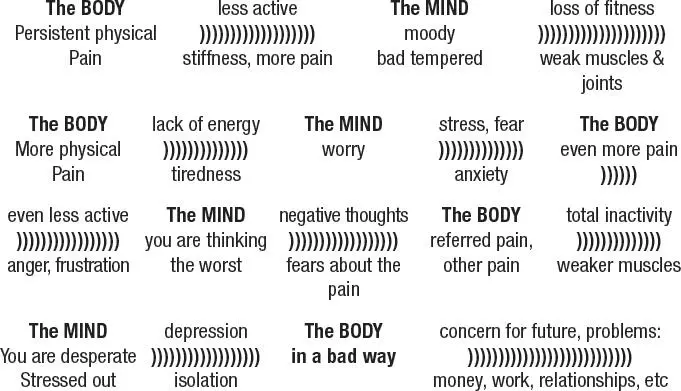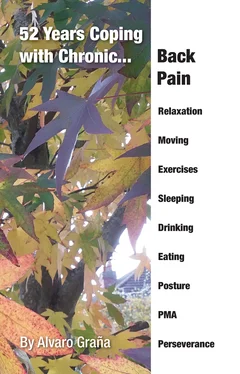As most chronic pain sufferers know, there are no treatments that can eliminate pain completely. However, according to the Gate Control Theory there are other ways to close the gate, for example:
– Pain relief medication
– Physical activity – walking, playing a garden game, swimming, etc
– Pacing activities – doing ‘something’ in stages
– Relaxation – meditation, slow deep breathing, relax tense muscles, etc
– Distraction – playing a board game (ie,: chess, cards, etc.), engaging in a hobby (painting, drawing, etc), watching a good film, etc
– Addressing stress and worries
– Sitting in a jaccuzi
– Having a warm shower
– Talking to a friend
– Reading a good book
– Interacting with other people – socialising
– Being positive and optimistic
More on these later on.
What opens the gate ?
– Worry and stress
– Being moody and bad tempered
– Feeling fed-up
– Feeling down
– Moaning and getting angry
– Not enough sleep
– Staying in one position too long
– Getting frustrated
– Being bored and not enjoying life
– Focusing on the pain - Going round in circles thinking about the pain
– Thinking ‘why me’ and feeling sorry for yourself
– Being negative
Personal experience - In the late seventies and all through the eighties my constant chronic pain continued to increase. My condition was going from bad to worse as I wasn’t doing anything about it. I had not taken on board anything I had learnt and I started having severe pains down my legs (especially my right leg). In 1988, by which time I had moved to Coventry, my condition was so bad that I went to see an orthopaedic Surgeon who recommended an operation to my lower back, to which I agreed because I could hardly walk 100 yards without having to stop for a rest. The consultant warned me about the odds: there was a 65% chance that I might end up the same or worse vs a 35% chance that I might find some unquantifiable benefit. I felt I had nothing to lose, so agreed to have the operation. The procedure was a fusion of two vertebrae (L5 and S1).
I was doing voluntary work at the time alongside looking after my 8 year-old daughter and my 4 year-old son. By then I was aware that stress affected my physical condition and aggravated my pain. I felt I was on a vicious downward spiral.
Vicious Spiral of Chronic Pain
As physical and psychological pain are very much linked together, here is a sequence of a possible downward spiral of chronic pain.

In this scenario the situation goes from bad to worse to completely out of control. It is a spiral rather than a circle. The aim must be to avoid getting into this downward spiral of pain.
Peronal experience – After my operation I had to spend 6 months convalescing at home with some physiotherapy and rest, gradually returning to a level of normality.
A year after my operation, I did a teacher training - PGCE course at Warwick University, which I completed in spite of my intense physical discomfort. The operation put me back to work, I got a job as a primary school teacher almost straight away so this might be perceived as a success story.
When I started teaching (1989-90) at Hearsall Community Primary School I did not take any medication other than paracetamol when required, but I found it very tough going. The work was both physically and mentally very demanding which resulted in constant lower back pains, and migraines and neck aches at times.
After my probationary year as a teacher I realised I needed further help with my condition. A friend recommended a chiropractor, whom I went to see (1991). After a few visits I began to notice my condition improving thanks to the treatment. I was going to my chiropractor every week to begin with, then booking appointments as and when necessary and was able to keep the pain under control for the rest of that year.
After a few years my marriage began to crumble adding another level of stress in my life, in addition to the stress from work. It eventually started to affect me physically and mentally and pain once again became more frequent and severe. My marriage ended in divorce, a very painful process. I continued in my determination not to take strong medication for a few more years until one day in 1999 while I was at work teaching 6-7 year-olds, sitting along side my pupils on a very small chair at an equally small table. At the end of the lesson I could not stand up, on a second attempt I felt a horrendous pain on my back and right leg and was unable to move. I was taken to the staff room by some of my colleagues but as I did not recover I was sent home. This was my darkest hour. Not even my chiro-practor could put me right this time, as he had done previously. I was unable to go back to work for the rest of that year and was on sick pay until it eventually became clear I had to retire on medical grounds in the year 2000.
After I retirerd on medical grounds I decided the time had come for me to take control and started the process of searching and learning more about my condition. It was during that year that I went back to my GP and agreed to try medication again. At the beginning I was dreading it, because of my negative experience with prescribed drugs in Peru between 1967 and 1970 , but felt I had no other option. I hoped medicine would have advanced and was relieved to discover that doctors no longer prescribe valium for chronic pain. I was prescribed painkillers, anti-inflammatories and antidepressants which helped aleviate the pains, but the side effects were horrible. This was the beginning of my third phase, a very dark phase. I started finding out about the different types of medication to manage chronic pain and avoid side effects.
Types of Medicine to manage Chronic Pain
There are four types of medicine available:
1. Analgesics: these are commonly known as ‘painkillers’, such as paracetamol, codeine, tramadol, morphine, among others. Chronic pain sufferers will testify that these drugs can help to reduce pain but do not relieve it completely, while producing side effects which can cause discomfort or pain, for example: constipation, itching, loss of concentration, nausea, dry mouth, mood changes, problems with sleep, to name but a few.
2. Anti-inflammatories: are used to reduce inflammation and pain in acute pain similar to that caused by a twisted ankle, and chronic pain such as in arthritis. The most commonly used anti-inflammatories are: ibuprofen, indomethacin and diclofenac, which are known as non-steroidal anti-inflammatory drugs (NSAIDs). Unfortunately these may also produce side effects such as: weakness and fatigue, dizziness, flu-like illness, diarrhoea, indigestion, stomach pain, heartburn, nausea, headache, bleeding from the gut, stomach or bowel.
3. Antidepressants: Drugs such as amitriptyline and imipramine are normally used to treat depression. Recent research shows they are also effective in reducing pain and pain-related sleep problems. The amitriptyline dose recommended to manage chronic pain is quite small, 5mg-25mg. Whereas a much higher dose, 100mg-200mg is used for treating depression. Amitriptyline may produce the side effects such as dizziness, constipation, stomach aches, blurred vision, poor concentration, dry mouth.
4. Anticonvulsants: These are used to deal with chronic pain, to treat epilepsy, and also to reduce pain coming from nerve fibres. The most common side effects are nausea and vomiting, dizziness, drowsiness, skin rashes, unsteadiness, and stomach aches. Nowadays the medical profession does not recommend the use of tranquilizers or muscle/mind relaxants, such as diazepam (vallium) for chronic pain as they often lead to dependency (addiction).
Читать дальше













